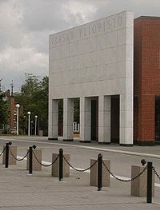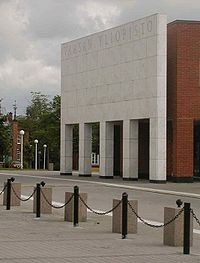
Simo Paavilainen
Encyclopedia
Simo Paavilainen is a Finnish
architect
, and former Dean and Professor of Architecture at Helsinki University of Technology
Department of Architecture.
Paavilainen studied architecture at Helsinki University of Technology, qualifying as an architect in 1975. Since 1977 he has run an architects' office in Helsinki together with his wife Käpy Paavilainen, Arkkitehtuuritoimisto Käpy ja Simo Paavilainen Oy. He was appointed Professor of Architecture at Helsinki University of Technology Department of Architecture in 1998, and dean of the school in 2004. He resigned his position in 2010 to return to private practice.
The work of the Paavilainens first came to attention in the early 1980s, at a time when Finnish critics were adamant that Postmodernism
was having no significant influence on architecture in Finland, one of the bastions of Modernist architecture. Against this trend the Paavilainens introduced a strain of playfulness, colour and irony into Modernism. While part of the reasons for their style of architecture is certainly derived from following international trends, this also took on a local concern: in attempting to gain academic respectability, the Postmodern theorists, such as Charles Jencks
, Michael Graves
and Charles Willard Moore
, turned their attention to earlier proto-Postmodernism, one of the prime examples being the architecture in the Nordic countries during the 1920s, so-called Nordic Classicism
, and in particular the Swedish
architect Gunnar Asplund
. Scholars in the Nordic countries became well aware of the international attention, and the architecture of that period, which had been forgotten in the onslaught of Modernism, was then 'rediscovered', as evident in various books and exhibitions. Simo Paavilainen emerged as one of the key academics in the field; but his interest then spilled over into his own architectural production. In more recent years, however, his architecture has moved back towards more traditional Modernism, though again, in the spirit of the times.

Finland
Finland , officially the Republic of Finland, is a Nordic country situated in the Fennoscandian region of Northern Europe. It is bordered by Sweden in the west, Norway in the north and Russia in the east, while Estonia lies to its south across the Gulf of Finland.Around 5.4 million people reside...
architect
Architect
An architect is a person trained in the planning, design and oversight of the construction of buildings. To practice architecture means to offer or render services in connection with the design and construction of a building, or group of buildings and the space within the site surrounding the...
, and former Dean and Professor of Architecture at Helsinki University of Technology
Helsinki University of Technology
Aalto University School of Science and Technology , was the temporary name for Helsinki University of Technology during the process of forming the Aalto University...
Department of Architecture.
Paavilainen studied architecture at Helsinki University of Technology, qualifying as an architect in 1975. Since 1977 he has run an architects' office in Helsinki together with his wife Käpy Paavilainen, Arkkitehtuuritoimisto Käpy ja Simo Paavilainen Oy. He was appointed Professor of Architecture at Helsinki University of Technology Department of Architecture in 1998, and dean of the school in 2004. He resigned his position in 2010 to return to private practice.
The work of the Paavilainens first came to attention in the early 1980s, at a time when Finnish critics were adamant that Postmodernism
Postmodernism
Postmodernism is a philosophical movement evolved in reaction to modernism, the tendency in contemporary culture to accept only objective truth and to be inherently suspicious towards a global cultural narrative or meta-narrative. Postmodernist thought is an intentional departure from the...
was having no significant influence on architecture in Finland, one of the bastions of Modernist architecture. Against this trend the Paavilainens introduced a strain of playfulness, colour and irony into Modernism. While part of the reasons for their style of architecture is certainly derived from following international trends, this also took on a local concern: in attempting to gain academic respectability, the Postmodern theorists, such as Charles Jencks
Charles Jencks
Charles Alexander Jencks is an American architectural theorist, landscape architect and designer. His books on the history and criticism of Modernism and Postmodernism were widely read in architectural circles and beyond....
, Michael Graves
Michael Graves
Michael Graves is an American architect. Identified as one of The New York Five, Graves has become a household name with his designs for domestic products sold at Target stores in the United States....
and Charles Willard Moore
Charles Willard Moore
Charles Willard Moore was an American architect, educator, writer, Fellow of the American Institute of Architects, and winner of the AIA Gold Medal in 1991.-Life and career:...
, turned their attention to earlier proto-Postmodernism, one of the prime examples being the architecture in the Nordic countries during the 1920s, so-called Nordic Classicism
Nordic Classicism
Nordic Classicism was a style of architecture that briefly blossomed in the Nordic countries between 1910 and 1930....
, and in particular the Swedish
Sweden
Sweden , officially the Kingdom of Sweden , is a Nordic country on the Scandinavian Peninsula in Northern Europe. Sweden borders with Norway and Finland and is connected to Denmark by a bridge-tunnel across the Öresund....
architect Gunnar Asplund
Gunnar Asplund
Erik Gunnar Asplund was a Swedish architect, mostly known as a key representative of Nordic Classicism of the 1920s, and during the last decade of his life as a major proponent of the modernist style which made its breakthrough in Sweden at the Stockholm International Exhibition...
. Scholars in the Nordic countries became well aware of the international attention, and the architecture of that period, which had been forgotten in the onslaught of Modernism, was then 'rediscovered', as evident in various books and exhibitions. Simo Paavilainen emerged as one of the key academics in the field; but his interest then spilled over into his own architectural production. In more recent years, however, his architecture has moved back towards more traditional Modernism, though again, in the spirit of the times.

A selection of buildings designed by Simo and Käpy Paavilainen
- Olari Church and Parish Centre, EspooEspooEspoo is the second largest city and municipality in Finland. The population of the city of Espoo is . It is part of the Helsinki Metropolitan Area along with the cities of Helsinki, Vantaa, and Kauniainen. Espoo shares its eastern border with Helsinki and Vantaa, while enclosing Kauniainen....
, 1976–1981. - Paimio Parish Centre, PaimioPaimioPaimio is a town and a municipality of Finland.It is located in the province of Western Finland and is part of the Finland Proper region. The municipality has a population of and covers an area of of which is water. The population density is...
, 1980–84. - Tritonia Library, University of VaasaUniversity of VaasaThe University of Vaasa is a multidisciplinary, business-oriented university in Vaasa, Finland. The campus of the university is situated by the Gulf of Bothnia adjacent to downtown Vaasa. The university has evolved from a school of economics founded in 1968 to a university consisting of three...
, 2001. - Local Government Pensions Institute, offices, Helsinki, 2005

